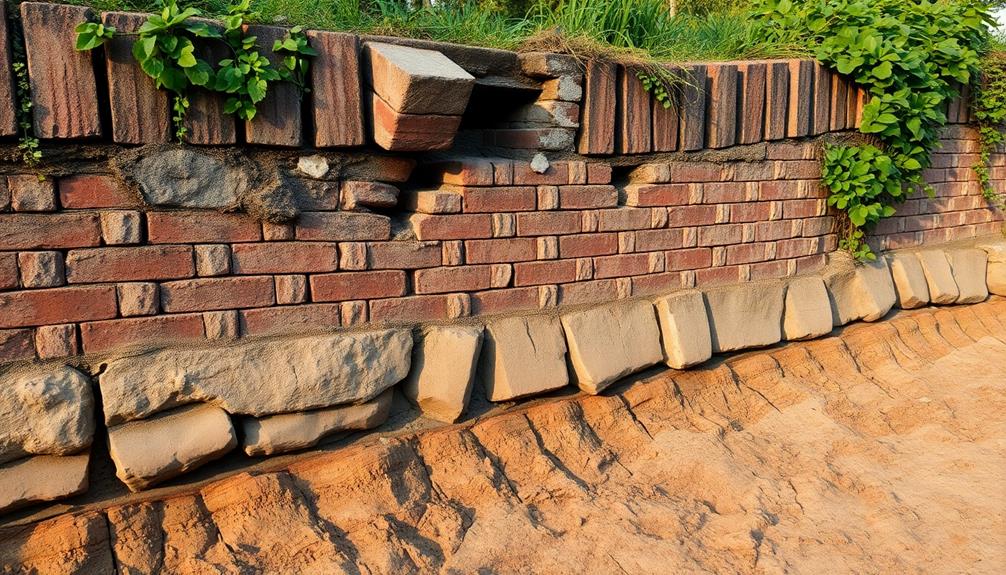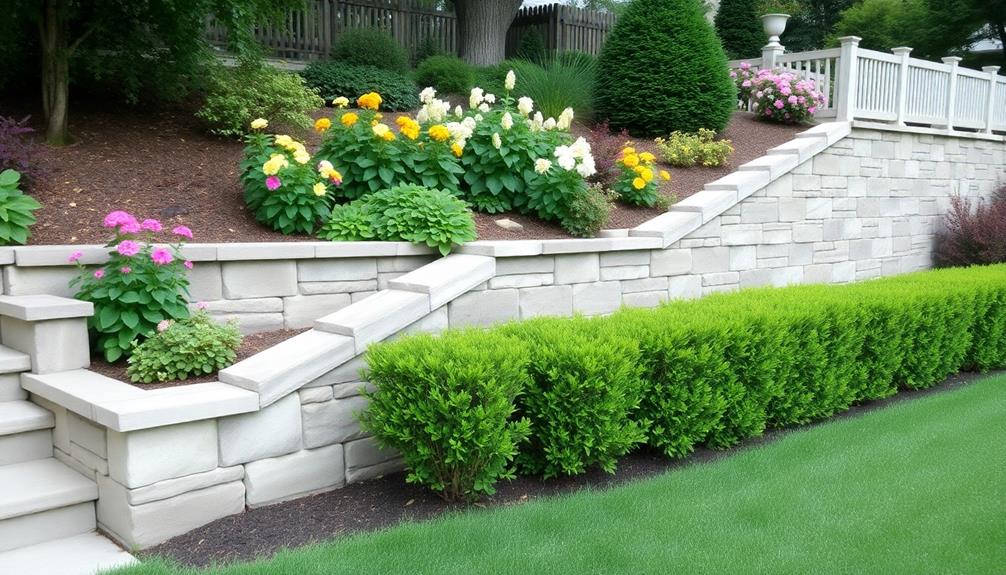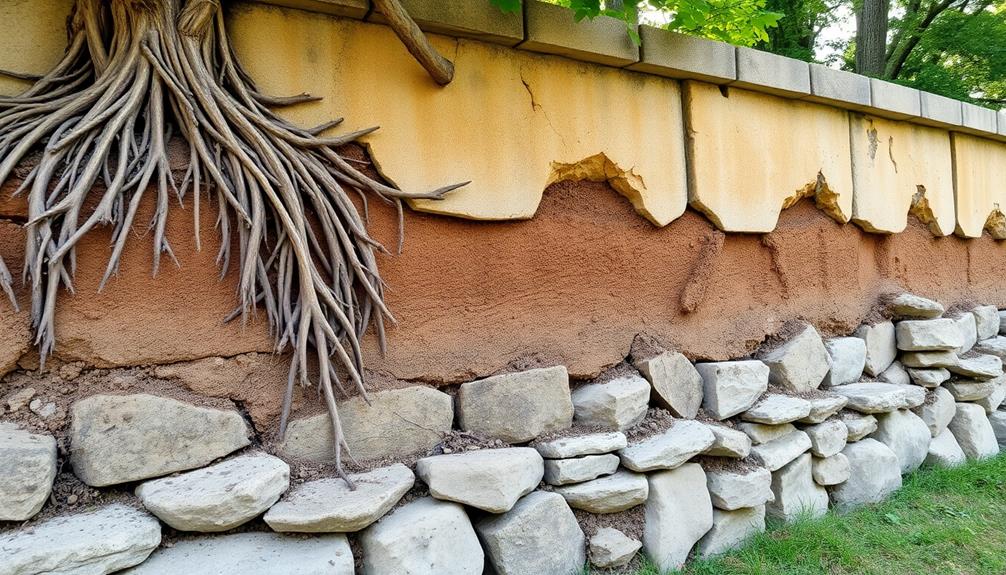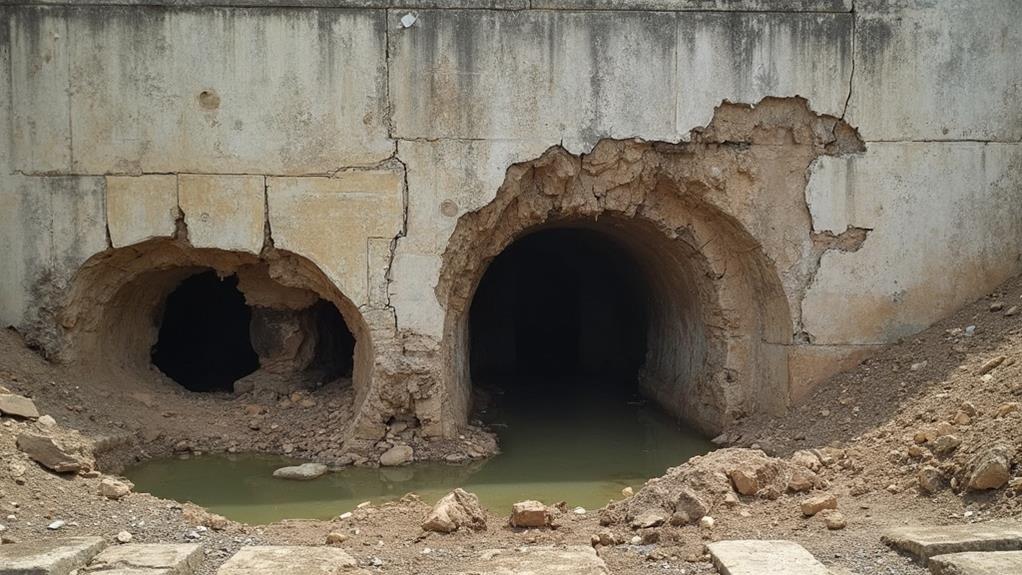A retaining wall's structural integrity can be compromised by various signs that necessitate repair. Key indicators include horizontal or step-like cracks that may signify foundational shifts, water damage evidenced by efflorescence or mildew growth, and visible soil erosion threatening the wall's stability. Also critical are foundation shifts, evidenced by tilting or bulging, and ominous soil erosion beneath the wall. Water pooling nearby and the emergence of gaps or sinkholes signal improper drainage and soil instability. Additionally, if plant roots penetrate and fracture the wall, immediate attention is required. Noticing these signs can be pivotal for maintaining a safe and stable structure.
Table of Contents
ToggleWalls Contractor Highlights
- Structural cracks or displacement indicate potential foundational shifts in the retaining wall.
- Water damage, such as efflorescence or mold, suggests excessive moisture compromising the wall.
- Tilting or bulging of the wall reveals possible foundation shifts needing repair.
- Soil erosion signs include washout or exposure of the wall's footing.
- Vegetation growth within the wall structure may cause cracks and displacement.
Understanding Wall Damage Basics

Understanding wall damage is vital in maintaining the integrity of retaining structures, beginning with the identification of structural cracks which may indicate underlying stress within the wall. Choosing the right retaining wall materials, such as durable boulder or limestone, can greatly reduce the risk of such stress and ensure long-lasting stability.
Equally important is the recognition of water damage, as improper drainage can lead to erosion and undermine the wall's foundation over time. Additionally, observing foundation shifts is essential, as these movements can compromise the wall's stability and necessitate immediate attention to prevent further deterioration.
Identifying Structural Cracks
How can one distinguish between mere surface blemishes and critical structural cracks in retaining walls? This question is pivotal for property owners, as understanding the nature of wall imperfections can determine the course of action needed to maintain the wall's integrity.
Superficial imperfections are often shallow and do not compromise the wall's core stability. These may include hairline cracks or efflorescence—an indication of natural surface wear. Conversely, structural cracks manifest as significant, deep fissures, often exhibiting widening gaps or displacement indicating potential failure of the wall system. The presence of these ominous signs typically suggests that the underlying load-bearing components are compromised, posing a risk of wall collapse.
To effectively identify structural cracks, one must observe the pattern and progression. Horizontal or step-like cracks, for example, frequently indicate foundational shifts or excessive force against the wall. Additionally, cracks wider than an eighth of an inch are cause for notable concern, warranting professional inspection. By empowering homeowners with knowledge to differentiate between trivial and severe wall conditions, we cultivate a community that can proactively preserve its surroundings. This sense of belonging and assuredness arises from a shared commitment to informed home care and vigilance.
Recognizing Water Damage
Having explored the critical identification of structural cracks, attention must also be paid to water damage, another formidable threat to the integrity of retaining walls. Water damage can manifest in several subtle but significant ways that, if identified early, can prevent extensive deterioration and costly repairs. Recognizing these indicators guarantees not only the longevity of your retaining wall but also maintains the aesthetic and safety aspects cherished by a community-minded audience.
Firstly, efflorescence—a mineral deposit left by evaporating water—often appears as a white, powdery substance on the wall surface. Additionally, mold or mildew evidence signifies excessive moisture, creating unsightly and potentially unhealthy conditions. Ultimately, the presence of discoloration or stains on the wall, especially in consistent patterns, may indicate ongoing water seepage, which can undermine wall structure over time.
These signs should compel homeowners, who value a sense of community and security, to take timely action. By recognizing and addressing water damage promptly, you not only safeguard the structural soundness of your property but also contribute to the overall well-being of your shared environment. Thus, instilling a proactive approach in maintenance reinforces your commitment to the shared goal of preserving both personal and community spaces.
Observing Foundation Shifts
Foundation shifts present a significant concern in the domain of wall damage, signaling potential structural vulnerabilities that require immediate attention. As these shifts occur, the underlying stability of a retaining wall is compromised, presenting risks that extend beyond mere aesthetic blemishes. Such movement within the foundation can lead to significant and costly damages if not addressed with urgency.
In observing a wall, signs of foundation shifts include noticeable tilting or bulging, which may indicate that the foundation soil has moved or settled unevenly. This movement often results from poor drainage, subsurface erosion, or seismic activity.
For those maintaining these critical structures, vigilance is paramount. Ensuring regular inspections can identify early indications of distress, such as hairline cracks or gaps emerging between wall segments, which might signify an underlying issue. Immediate response to these signs fosters a sense of safety and security within your community, as proactive maintenance extends the lifespan of a retaining wall, preserving its functional integrity.
In employing professional services, experts evaluate the extent of the shift, offering solutions tailored to rectify and stabilize the foundation, ultimately restoring confidence in the structure's capability to safeguard landscaped environments or property boundaries.
Benefits

Retaining wall repair offers numerous benefits that extend beyond immediate structural concerns, primarily by enhancing the wall's longevity and consequently securing the property's foundation. By addressing issues promptly, property owners not only prevent soil erosion—a common catalyst for further damage—but also increase the overall property value through improved stability and aesthetic appeal.
Repairs guarantee the retaining wall's structural integrity, providing pivotal support and stability to the landscape. These repairs not only preserve the integrity of the landscape but also amplify its visual and financial worth, assuring long-term satisfaction and security for property investments.
Enhances Structural Longevity
Properly repairing a retaining wall substantially boosts its structural longevity, guaranteeing it withstands environmental stresses over time. This vital maintenance task provides the strength and endurance necessary for the wall to perform its essential retaining duties, creating a sense of stability and security for any space it surrounds. By addressing underlying issues promptly, the risk of costly future failures diminishes extensively. This approach extends the life expectancy of retaining walls by shielding them against multiple structural threats.
When a retaining wall's integrity is prioritized, several advantages arise that emphasize long-term benefits:
- Resilience Against Weather: Comprehensive repairs prevent water infiltration and frost damage, essential for areas with unpredictable climates, thereby avoiding the erosion and shifts that often compromise wall stability.
- Sustained Load-Bearing Capacity: Expert repairs maintain the wall's ability to support the soil it contains, thus preventing sudden pressure-induced collapses and further structural fatigue.
- Material Preservation: Repair work often involves reinforcement or replacement of materials that might have deteriorated, ensuring that the wall remains as good as new over extended periods.
Adopting a proactive repair strategy not only guarantees the retaining wall's durability but also reinforces the communal trust and unity around shared spaces, safeguarding their use for generations.
Increases Property Value
A well-maintained retaining wall substantially enhances property value by contributing to the overall aesthetic appeal and functionality of the landscape. When retaining walls are in prime condition, they project an image of care and attention, which resonates with potential buyers and can markedly elevate a property's marketability. The visual allure of an expertly crafted retaining wall can seamlessly complement the architectural elements of a home, harmonizing with existing design features and natural surroundings while asserting a sense of order and sophistication. This enhancement in curb appeal paves the way for a lasting impression that can help elevate property evaluations.
Moreover, a well-kept retaining wall also reflects practical functionality, creating usable outdoor spaces that families can enjoy. By transforming uneven or steep terrains into flat, usable areas, the wall serves not merely as a boundary but as a medium to enhance the living space—offering flower beds, walkways, or seating areas that naturally integrate into the environment. Prospective buyers perceive these features as assets, speaking to an added dimension of lifestyle opportunities. Consequently, such additions lend significant leverage in real estate negotiations by underscoring the value brought by functional and aesthetic improvements.
Prevents Soil Erosion
The effectiveness of a well-maintained retaining wall in mitigating soil erosion cannot be overstated, as strategic design and robust construction play important roles in stabilizing the terrain. For communities that face the relentless challenge of soil displacement due to environmental factors, retaining walls provide not only protection but also preservation of cherished landscapes.
By countering the effects of erosion, these structures build a foundation of stability that benefits both natural and constructed environments.
Retaining walls serve as an essential tool to prevent soil erosion through the following mechanisms:
- Soil Containment: By physically holding back soil, retaining walls prevent erosion caused by rainfall runoff and wind, maintaining the integrity of sloped landscapes.
- Water Diversion: Engineered with effective drainage systems, retaining walls redirect excess water away from vulnerable slopes, reducing hydraulic pressure and preventing slips or landslides.
- Land Stability: By reinforcing gradients, these walls counteract the natural downward movement of soil, indispensable for safeguarding home foundations and public infrastructure.
In a close-knit community where landscapes often define our shared space, a dependable retaining wall is not just a structural necessity; it's an embodiment of our commitment to preserving and nurturing our environment for future generations.
Improves Aesthetic Appeal
Functioning beyond their practical role in soil retention, retaining walls can substantially enhance the aesthetic appeal of a landscape. Their presence transforms uneven terrains into cohesive and visually pleasing spaces. When strategically placed and well-maintained, retaining walls can be the central visual feature that ties together various landscape elements, from lush gardens to serene walkways. As part of the architectural harmony, they offer a structured beauty that seamlessly integrates with the natural surroundings, creating an inviting atmosphere for any homeowner.
The materials chosen for these walls—ranging from natural stones to sleek concrete—can reflect personal style while blending with the existing environment. When properly cared for, these walls can showcase their textures and colors vividly, adding layers of depth and visual interest to the landscape. Regular inspections and repairs guarantee that the aesthetic attributes of the wall are not compromised by cracks or unsightly wear, preserving its visual integrity.
Additionally, retaining walls offer opportunities for creative expression such as incorporating lighting or planters, further enhancing their visual impact. Ultimately, a well-cared-for retaining wall not only serves a structural purpose but also enriches the overall ambiance of the property, fostering a sense of belonging and warmth.
Soil Erosion Indicators

Understanding soil erosion indicators is pivotal for maintaining the integrity of a retaining wall, as these signs often precede more significant structural concerns. Key indicators such as visible soil displacement, water pooling nearby, and exposed wall footing are essential to monitor, as they can reveal underlying erosion that may jeopardize the wall's stability. The following table provides a succinct overview of these indicators and their implications:
| Indicator | Implication |
|---|---|
| Visible Soil Displacement | Suggests soil instability or movement |
| Water Pooling Nearby | Indicates potential drainage issues |
| Exposed Wall Footing | Signals erosion undermining support |
Visible Soil Displacement
Numerous signs of visible soil displacement serve as critical indicators of soil erosion, highlighting potential threats to the structural integrity of retaining walls. Recognizing these early signs can facilitate timely interventions, consequently protecting not only the structure but also the cohesion within our communities. Such visible signs might manifest in multiple forms, each requiring a keen eye to identify and properly assess their implications.
- Slope Failure: The contour of the soil at the top or base of the wall might exhibit irregularities or changes, indicating that gravity and time are slowly winning the battle against engineered stability.
- Gaps Between Wall and Soil: As soil shifts away or becomes loose, spaces may form between the retaining wall and the ground it once supported, suggesting that remedies are essential to prevent wall collapse.
- Cracks in the Soil: These indicate stress and movement often associated with underlying erosion processes, warning of potentially larger structural concerns if left unaddressed.
When these signs are observed, consulting a professional to inspect the wall can assure that both preventive measures and necessary repairs are undertaken promptly, reinforcing not just physical structures but also our shared environments from potential hazards.
Water Pooling Nearby
While visible soil displacement provides clear signals of potential structural jeopardy, water pooling nearby is another pivotal indicator of soil erosion that demands immediate attention. This phenomenon often surfaces after heavy rainfall or excessive watering when drainage systems fail to direct water away from the foundation of the retaining wall. Such pooling not only underscores inadequate drainage but also signifies that water may be penetrating and weakening the structural integrity of the wall. With the accumulation of water, soil stability is compromised, creating conditions ripe for erosion and subsequently fostering ground instability and potential wall failure.
Recognizing water pooling as a symptom of underlying erosion issues is indispensable for proactive maintenance of retaining walls. The presence of standing water near your wall serves as both a visible warning and a call to action to address drainage deficiencies. Immediate steps include inspecting and upgrading existing drainage solutions, such as adjusting the slope of the ground for optimal runoff, installing weep holes, or employing French drains to efficiently channel water away. By attending swiftly to these signs, property owners can help guarantee their retaining walls continue to serve as steadfast guardians, providing stability and support for the landscapes with which they are entrusted.
Exposed Wall Footing
A prominent indicator of soil erosion around retaining walls is exposed wall footing, which poses significant risks to structural stability. Such exposure indicates that the soil, intended to provide essential support and prevent displacement, is succumbing to erosive forces, thereby undermining the wall's integrity. As the foundational elements become visible, they compromise the structure's ability to effectively restrain soil, thereby posing a considerable threat to adjacent properties and landscapes. With this sign, the urgency for intervention becomes apparent, demanding attention to preventive measures and restorative solutions.
Identifying exposed wall footing allows property owners to recognize deeper issues that need addressing, often involving a meticulous analysis of drainage and structural dynamics. Assess the Extent of Erosion: Determine the degree of footing exposure and active soil loss to understand potential impacts on structural stability. Enhance Drainage Systems: Implement effective water management practices to minimize future erosion, such as installing proper drainage pipes or adjusting slope gradients. Reinforce and Repair: Engage with professional services to reconstruct or reinforce the wall footing, ensuring it is adequately protected against future erosion threats.
Walls Contractor FAQ
How Often Should Retaining Walls Be Inspected for Potential Issues?
Retaining walls should be inspected annually to guarantee structural integrity and community safety. Regular evaluations foster peace of mind and unity, safeguarding our shared spaces by addressing potential issues before they escalate, preserving the wall's functionality and aesthetic appeal.
What Tools Are Essential for DIY Retaining Wall Repairs?
When undertaking DIY retaining wall repairs, essential tools include a level, tamper, wheelbarrow, shovel, and masonry tools. Additionally, acquiring a tape measure, protective gear, and materials for patching guarantee safety and precision, reinforcing community values in craftsmanship.
Can Weather Conditions Affect the Lifespan of a Retaining Wall?
Adverse weather conditions, such as heavy rainfall, frost, and extreme temperatures, can considerably impact the structural integrity and lifespan of retaining walls. Regular maintenance and timely interventions guarantee the community's shared spaces remain safe, resilient, and aesthetically pleasing.
Are There Specific Materials That Enhance the Durability of Retaining Walls?
Yes, certain materials like reinforced concrete, stone, and interlocking blocks remarkably enhance retaining wall durability. Choosing high-quality materials fosters long-lasting constructions, ensuring stability and safety, and instilling a sense of community pride in well-maintained infrastructural landscapes.
How Can I Find a Certified Professional for Retaining Wall Repairs?
To find a certified professional for retaining wall repairs, consult local contractor directories, verify certifications through industry associations, and solicit recommendations within community forums to guarantee reliable expertise, fostering a sense of belonging through shared experiences and trust.







